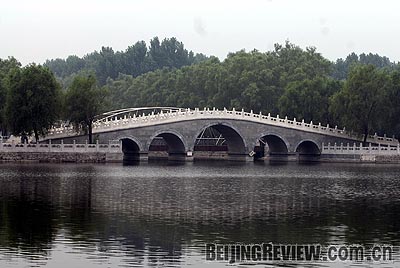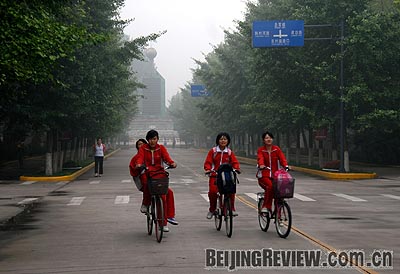|

BRIDGE TO AFFLUENCE: The residents of Hancunhe Village are proud of their construction techniques. They modeled this bridge after a famous one in an ancient royal park
Li Kai, a farmer in his 70s, lives in Hancunhe Village in Fangshan District of Beijing suburbs. He takes charge of guarding his old house near the 330-square-meter villa he now lives in and receives 260 yuan ($37.90) a month for the job. The old house of Li now serves as a museum to mirror the village life 30 years ago. His wife receives the same amount for cleaning a 20-meter section of the street in front of their house. Besides the 280 yuan ($40.23) basic monthly pension that the Beijing Municipal Government gives Li and his wife, they also receive an additional living allowance of 210 yuan ($30.17) a month from Hancunhe Village. With all the money the old couple receive each month, they can easily afford their living expenses.

A CYCLING WE GO: The streets of Hancunhe Village are like those in cities
Today Hancunhe Village has an annual per-capita income of 18,000 yuan ($2,586.21). But 30 years ago, the residents lived a totally different life, said Zhang Yu, a guide at the Beijing Hancunhe Tourism Development Co. In 1978, when China launched its reform and opening-up policy, the village's per-capita annual income was only 50 yuan ($7.18). But the introduction of the reform and opening-up policy set Hancunhe on a path to becoming a wealthy, model suburban village.
Li Dejiang, a 70-year-old villager who has seen many changes take place there over the last 30 years, said the only source of income for the 700
| 